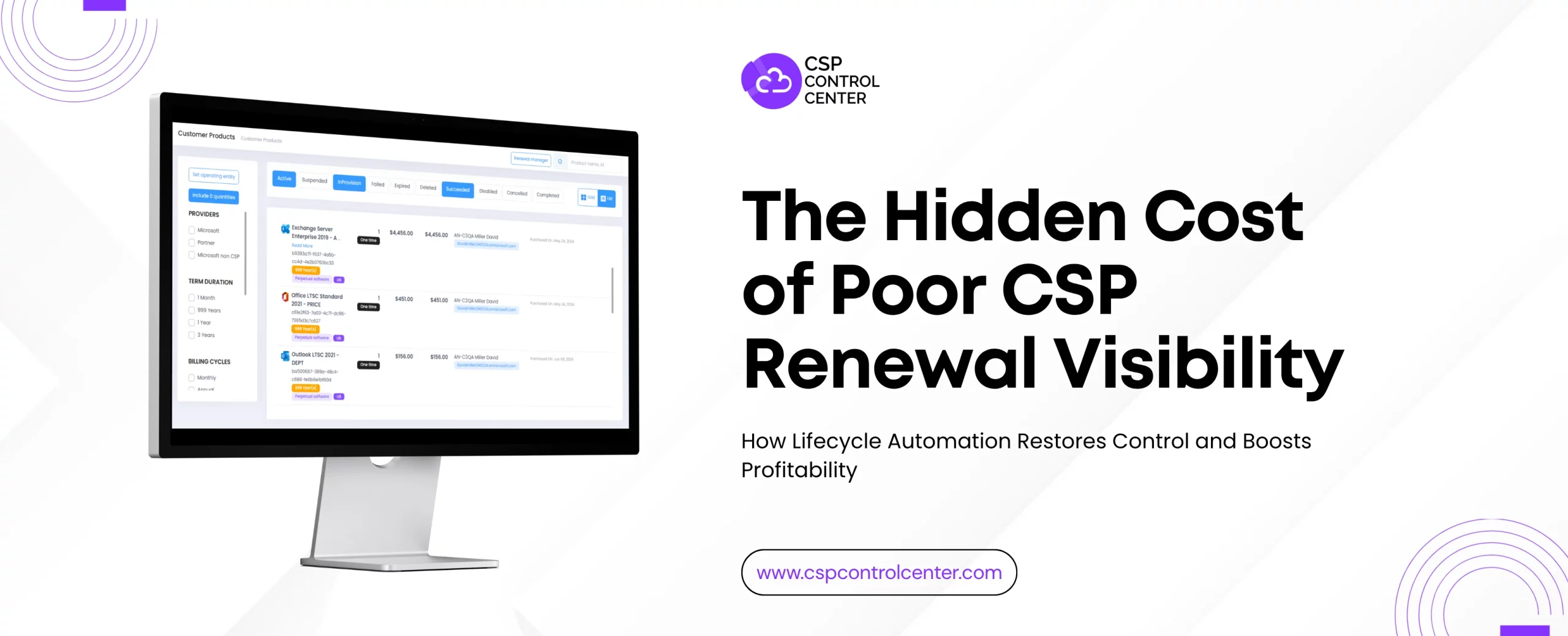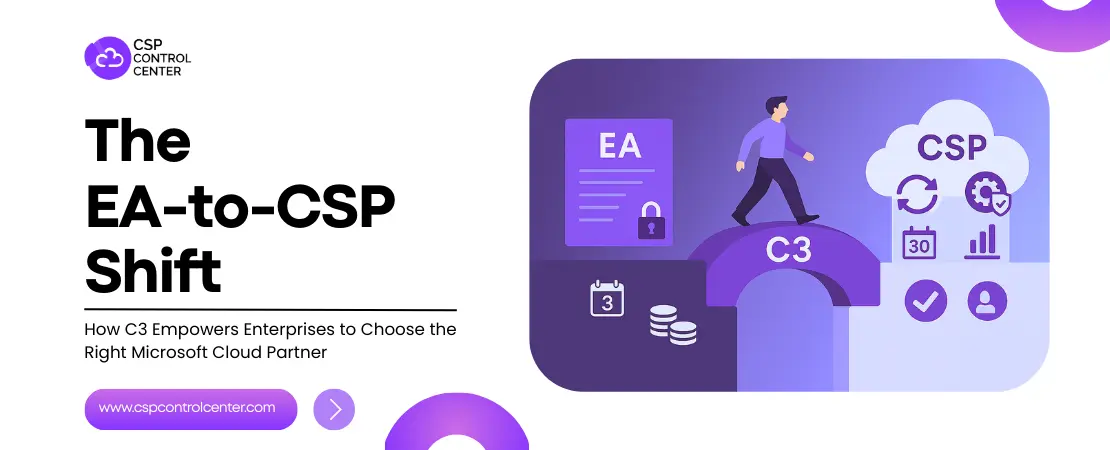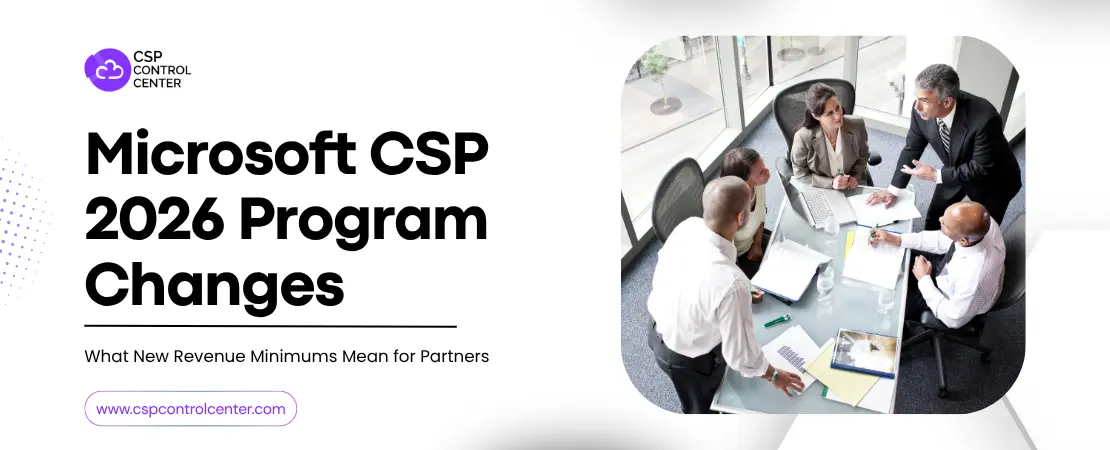In today’s cloud economy, CSP renewal visibility plays a critical role in determining the success of your Microsoft CSP business. The way you manage renewals directly impacts how effectively you retain customers and maintain predictable recurring revenue. Accurate and timely subscription renewals generate predictable monthly recurring revenue, the lifeline of any Microsoft CSP business. Yet, renewals are often the most overlooked and least visible part of a CSP’s operations.
It’s not the lack of sales that might be the reason you are losing margin and revenue, but what happens after the sales that makes the difference. When you are managing hundreds of active subscriptions, without clear visibility into renewal dates, usage patterns, and contract terms, opportunities slip away. Each loss may seem small on its own, but together they can quietly eat away at your profitability. Manual processes make things worse, introducing delays, inconsistencies, and missed opportunities in what should be a steady and reliable revenue stream.
Why Renewals Are the Silent Profit Driver in the CSP Business
Renewals are the silent profit driver in a subscription business model. Renewals generate consistent, predictable revenue with lower cost of acquisition compared to onboarding new customers. However, renewals are no longer a simple process. The growing complexity of renewals is due to evolving customer needs, diverse subscription tiers, and regulatory changes. As a Microsoft CSP, you have to manage multiple customer tiers, varied subscription terms, and a mix of legacy and New Commerce Experience (NCE) agreements. Each layer adds more administrative burden and more chances for human error. Without structured processes and automation, you might find it hard to maintain accurate visibility into contracts and license expirations.
Lifecycle automation can help in regaining control and boosting profitability. It allows you to monitor every stage of the subscription journey, automate renewals, and make informed decisions based on data rather than assumptions. Automation transforms renewals from a reactive administrative task into a proactive, strategic revenue driver.
This blog explores the hidden costs of poor renewal visibility, how lifecycle automation restores revenue control, and practical strategies to build predictable renewal pipelines.
Understanding CSP Renewal Visibility in the CSP Ecosystem
Renewal visibility in CSP business is much more than simply tracking renewal dates. In the context of a subscription-based business model, it means the clarity and accuracy that you have over every subscription term, renewal date, and associated revenue stream. Renewal visibility means knowing not just when a subscription expires, but also whether the customer is actively using their licenses, if they’re likely to renew, and what opportunities exist for expansion or optimization.
Renewal visibility covers several elements
- License Expiry: Tracking the precise start, end, and renewal window for every SKU and service commitment.
- Contract Terms and Commitments: Understanding annual or multi-year obligations under New Commerce Experience and legacy subscriptions.
- Customer Usage Metrics: Monitoring usage patterns to identify potential upsell or right-sizing opportunities before renewal.
- Payment and Billing Tracking: Ensuring payments align with renewal cycles to avoid unbilled or delayed revenue.
Why Renewal Visibility Is Hard to Achieve in Today’s CSP Model
CSP operations have grown more demanding as customers adopt multiple cloud products with varying billing cycles. You have to manage subscription types across monthly, annual, and multi-year terms. You might be handling hundreds of tenants with varying start and end dates, renewal clauses, and pricing tiers. Without automation, tracking these details becomes an operational nightmare, leading to poor CSP renewal visibility and missed revenue opportunities. Here are a few factors that make it hard to achieve renewal visibility.
Fragmented Systems
This is where most renewal problems start. Your billing data might be stored in the ERP system, provisioning details in Microsoft Partner Center, and customer information is in the CRM. As these tools may not be synchronized, the data becomes scattered and unreliable. As all this renewal data exists in silos, there can be chances of data mismatch, and your team has to put in extra effort to manually consolidate the data and rectify the errors.
Manual Renewal Tracking
Despite handling significant recurring revenue, you might still depend on spreadsheets to track renewals manually. These sheets become outdated as soon as a license is added or changed. This method is prone to human errors, difficult to share, and impossible to scale as your customer base grows.
NCE’s Fixed-Term Commitments
The New Commerce Experience has brought structure to the CSP model but also reduced flexibility. Its fixed terms and strict renewal timelines mean that even a small mistake can cause financial loss, missed deadlines, or billing issues.
Multiple Partner Levels
If you are working with indirect resellers, you can face even more challenges in maintaining renewal visibility. Each reseller adds another layer of data, which delays updates and increases the chance of errors. This makes it difficult for you to get a real-time view of each customer’s renewal status.
Lack of Forecasting or Centralized Dashboards
Without a unified platform, renewal data remains scattered across multiple tools. As a result, you operate reactively rather than strategically. You can only look at past reports instead of seeing what is coming next. This limits your ability to forecast renewals, reduce churn, or plan renewal efforts in advance.
The Hidden Costs of Poor CSP Renewal Visibility
Poor CSP renewal visibility can silently drain your profits over time, causing leaks that most partners don’t even notice. The renewal leaks often go unnoticed, hidden behind spreadsheets, manual updates, and delayed reconciliations. Here are some specific costs CSPs face when renewals are mismanaged or delayed.
Revenue Leakage
Missed or delayed renewals directly reduce predictable recurring revenue. When renewals are not tracked properly, you might fail to bill customers on time or miss contract renewals altogether. As a result, there could be a temporary halt in service, disrupting cash flow and allowing your customers to look for a new provider. According to data from Microsoft, “Partners who engage in timely renewals achieve a 20% higher revenue recapture rate compared to those who renew late.”
Without timely renewal alerts, your account managers lose opportunities to negotiate upsells or cross-sells with existing customers.
Margin Compression
Without clear historical insights or renewal forecasting, you might resort to last-minute discounting to retain customers. This reduces renewal margins and impacts overall profitability.
Lack of insight also leads to suboptimal pricing. Without data, you cannot adjust rates based on market trends or customer value, resulting in deals that undervalue services and hurt long-term profitability.
Operational Inefficiency
Manual tracking and spreadsheets consume hours of admin work. Teams spend hours reconciling data, validating invoices, and chasing customers for confirmations. As the number of subscriptions scales, this manual process simply cannot sustain accuracy and leads to customer dissatisfaction.
Customer Trust and Retention Risks
Missed renewals or unexpected service disruptions can strain customer relationships. Customers expect their CSPs to manage contracts seamlessly. When renewals are missed or communication is delayed, customers perceive you as disorganized and untrustworthy. This perception drives churn as customers seek partners whom they can rely on.
Compliance and Billing Errors
Renewal mismanagement often results in misinvoicing, creating both financial and compliance risks. Under Microsoft’s CSP program, you are responsible for maintaining accurate records and ensuring billing alignment with customer commitments. Poor renewal visibility can lead to reporting inconsistencies, audit issues, and compliance failures.
Where Manual and Traditional Processes Break Down
Manual renewal management depends on people remembering to check dates, send notifications, and update systems accurately. Manual renewal management works when you are handling a small customer base, but as your customer base grows, these traditional processes fail.
If you are manually tracking renewals, then probably your renewal data is available across multiple spreadsheets and emails. Tracking renewals like this is reactive, where your teams act only when renewal dates approach or when a customer complains of service being suspended. As a result, there is no time for strategic intervention, and you tend to miss out on opportunities. Because responsibility is often shared between sales, billing, and support, no single team maintains a complete view of the renewal pipeline. This fragmentation means opportunities for early renewals, upsells, or multi-term purchases are frequently missed.
As manual renewal processes are dependent on humans, this leads to delays, errors, and inconsistencies. NCE’s fixed-contract model further intensifies these problems because renewals must now be processed within specific windows. Missing even a single date can lock a customer into an unwanted contract.
Lifecycle Automation: What It Means for CSPs
Lifecycle automation represents a shift from reactive to proactive renewal management. For CSPs, it means managing the entire customer journey from onboarding and provisioning to billing, usage monitoring, and renewal through a single automated flow.
Lifecycle automation means every stage of a customer’s subscription is connected and visible. It goes far beyond simple billing automation and is built on several key components:
- Automated provisioning ensures subscriptions are deployed accurately and quickly.
- Usage tracking provides continuous visibility into how customers utilize their licenses and services.
- Intelligent invoicing automatically generates accurate bills.
- Renewal alerts trigger proactive communications well before expiration dates.
How It Restores Control
Lifecycle automation gives you the visibility and control you need to manage renewals proactively. Instead of reacting to missed deadlines or billing errors, you can anticipate, plan, and act strategically.
Centralized Dashboards for Real-Time Visibility
A single dashboard gives you a complete view of all upcoming renewals and term commitments. This helps identify which subscriptions need attention and prevents last-minute surprises.
Intelligent Forecasting and Alerts
Predictive analytics use data to forecast upcoming renewals and send timely alerts. This ensures you can act before a renewal lapses and keep cash flow steady.
Integration with Partner Center and Billing Systems
When data flows smoothly between Partner Center, billing platforms, and other tools, manual work drops significantly. This integration ensures accurate records and fewer reconciliation errors. Read our blog to learn about essential integrations for Microsoft CSPs.
Enhanced Customer Experience
Customers benefit from timely updates, renewal reminders, and flexible options. Clear communication builds trust and encourages long-term relationships.
Best Practices to Improve Renewal Visibility and Control
Lifecycle automation is a critical step in improving renewal visibility, but it is only effective when paired with strong renewal management processes. Here are a few best practices that help ensure technology aligns with business goals.
Centralize Renewal Data
Start by gathering all renewal-related information from spreadsheets into the automated lifecycle management platform. When customer details, contract terms, billing records, and renewal dates are spread across systems, important updates often get missed. Consolidate this data into a single view so that every team, from sales to finance, stays aligned and informed. It makes tracking renewals easier, reduces manual work, and improves decision-making.
Automate Alerts and Notifications
Use lifecycle automation tools to set up notifications that inform internal teams about upcoming renewals and send customers timely reminders as well. Configure alerts to trigger at multiple intervals (90 days, 60 days, 30 days, 14 days before renewal) to give teams adequate time for customer outreach and planning.
Segment Customers by Renewal Risk
Early warning signs such as low license usage, billing delays, or unresolved support tickets can indicate a customer might not renew. Use analytics to monitor these patterns and flag high-risk accounts well before renewal. Prioritize reaching out to high-risk customers, understanding their concerns, and taking steps to retain them.
Integrate Systems
Disconnected tools create gaps in visibility. Connect billing, provisioning, and customer data for complete traceability and visibility. When different systems are connected, you can view accurate, real-time information about customer subscriptions, making renewals more predictable and efficient.
Establish Renewal Ownership
Clearly define who is responsible for renewals within your organization. Whether it’s your sales, account management, or customer success team, defined ownership ensures follow-ups happen consistently.
Monitor and Optimize KPIs
To improve renewal visibility, you must measure what matters. Keep track of renewal rate, churn rate, and revenue retention. These numbers show how effective your renewal process is and where adjustments are needed.
Leverage Analytics for Forecasting
By analyzing customer patterns, you can predict which customers are likely to renew, upgrade, or churn. With these insights, you can plan renewal strategies in advance, improving both customer experience and profitability.
You can learn more by accessing this curated collection of Microsoft content focused on renewal strategy, retention, and upsell opportunities.
Choosing the Right Lifecycle Automation Platform
When you select the right lifecycle automation platform for your Microsoft CSP business, you go from simply tracking renewals to truly managing them. Not every platform has the same features and delivers similar value. If you choose the wrong platform, it might create more problems. You need to look for a lifecycle automation platform that fits into your processes, integrates with your existing systems, and is able to scale as your business grows. Here are a few points you should consider while evaluating different platforms.
Integration Capabilities
Your CSP business does not run in isolation. A good automation platform should connect easily with your core systems, such as Microsoft Partner Center, ERP, CRM, and accounting tools. When all your systems are connected and communicate seamlessly, renewal data flows smoothly. Apart from the popular integrations, look for platforms that offer custom integrations for your specific business needs.
End-to-End Automation
As a Microsoft CSP, it is your responsibility to manage the entire customer lifecycle, not just a few parts of it. So, the lifecycle automation tool that you choose should also be capable of managing the full customer lifecycle from provisioning and billing to invoicing and renewals. When you are able to manage each stage within one system, it reduces complexity and minimizes errors caused by switching between multiple tools. This also allows your teams to focus more on strategy and customer engagement rather than repetitive administrative work.
Customizable Workflows
Every Microsoft CSP operates differently. The platform must be flexible enough to align with your specific partner model (direct bill, indirect provider, or indirect reseller) and your customer segmentation. It should allow you to create custom renewal timelines and communication templates for different tiers of service.
Predictive Intelligence and Reporting
A lifecycle automation platform should not only automate processes but also offer meaningful insights. Predictive analytics can help you identify customers who are at risk of churning, highlight upcoming renewals, and suggest the best times to engage with customers.
Apart from this, the platform should have built-in reporting tools to make it easy to track renewal performance, measure revenue trends, and monitor customer behavior across different subscription terms.
Security and Compliance
As a CSP, you handle sensitive billing and customer data, making security a priority. Ensure that the platform aligns with Microsoft’s compliance framework and follows strict data protection standards. This not only builds trust with customers but also protects you from fines and regulatory actions.
As a Microsoft CSP, renewal management might be one of the most overlooked areas of your business. You might be focusing only on acquiring new customers or expanding service portfolios. Poor visibility into renewals leads to missed opportunities, delayed revenue, and unnecessary strain on customer relationships. In today’s competitive cloud economy, manual renewal tracking is no longer sustainable. Lifecycle automation is not just a tool, it is a strategy for long-term growth and control.
By automating every stage of the customer lifecycle, you can move from a reactive approach to a proactive one. By improving renewal visibility, you not only gain operational efficiency but also enhance customer experience, protect margins, and achieve sustainable growth.
Take Charge of Renewals with CSP Control Center
CSP Control Center (C3) simplifies renewal management by connecting every stage of your cloud lifecycle from provisioning and billing to forecasting and renewals. With real-time dashboards, predictive insights, and full integration with Microsoft Partner Center, C3 helps you see every renewal before it becomes a risk.
From automated invoicing and renewal alerts to Azure cost management and multi-tier partner support, C3 gives you the visibility and control you need to protect margins and accelerate growth.
Book a demo to explore how lifecycle automation can transform your renewal process.

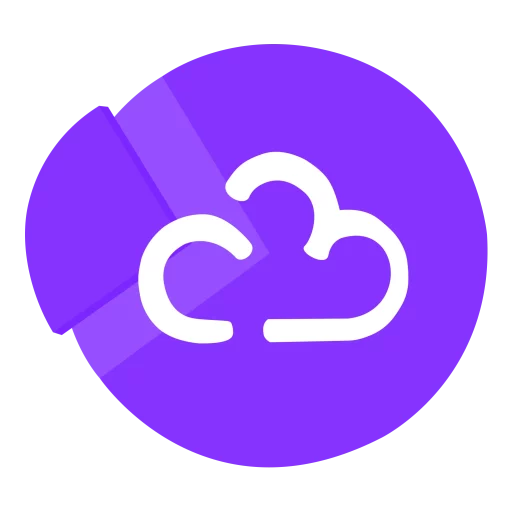 CSP Control Center
CSP Control Center
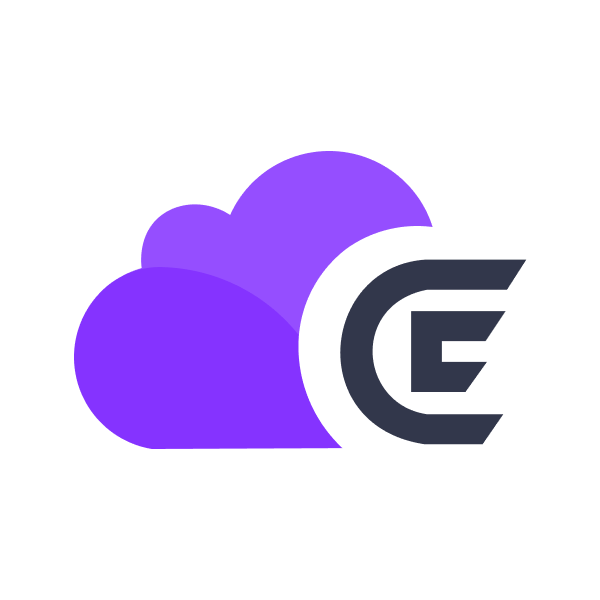 CloudEvents
CloudEvents
